WARM UP
Roll Out:
Lats
Upper Back/Traps
Chest/Shoulders
Forearms
Stretch:
Wrist Extension
Kneeling Thoracic Extension and Lat Stretch
Quadruped Thoracic Rotation
Lying Chest Stretch and Scorpion
Camel
ACTIVATION
Complete 1 round of the activation exercises below.
CIRCUIT:
10 reps Shoulder Flossing
10 reps each way 3-Way Scapular Band Flyes
10 reps Straight Arm Shoulder Extension
WORKOUT
Complete 3-5 rounds of each circuit. It is important that you work on feeling your back engage and make sure that your upper traps don’t take over. Rest as needed between rounds and 1-2 minutes between Circuits. If you need to rest between exercises, you can rest between exercises.
CIRCUIT #1:
30 seconds Scapular Wall Hold
10 reps Mini Pull Ups
3-5 reps each side Halos
CIRCUIT #2:
30 seconds Dip Hold
10 reps Inverted Rows
5-10 reps per side Plank with Shoulder Taps
COOL DOWN
Stretch and Roll Out:
Lats
Upper Back
Traps
Shoulders
Chest
Forearms
NOTES:
Really focus on form and your back working and not your upper traps taking over.
EXERCISE DESCRIPTIONS:
Wrist Extension – To do the Wrist Extension Stretch, kneel on the ground and place your hands down on the ground in front of you, palms down. Turn your fingertips out and back toward your knees. Then rock back, sitting on your heels, keeping the heels of your palms down on the ground as you sit back. Come back out of the stretch then sit back again, stretching down the inside of your forearms.
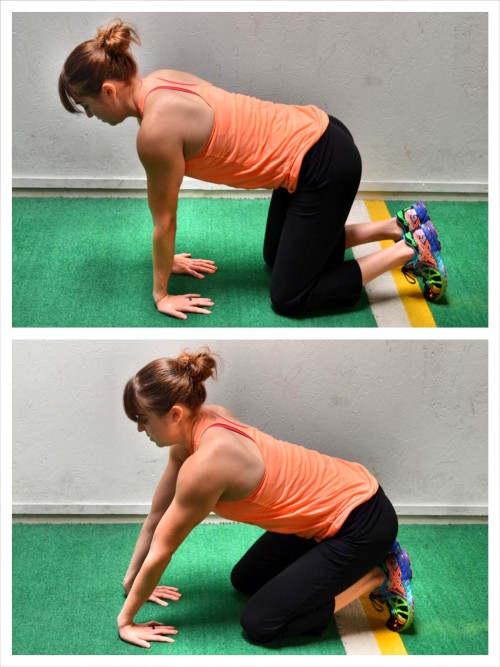
Kneeling Thoracic Extension and Lat Stretch – To do the Kneeling Thoracic Extension and Lat Stretch, place your elbows up on a bench about shoulder-width apart and kneel on the ground in front of the bench. Make sure you are back far enough that you have room to lean forward and over and drop your head between your elbows. Then with your elbows on the bench, relax your chest and head over, sitting your butt back just slightly. Press your chest toward the ground and feel a nice stretch down your triceps and lats as well as through your thoracic spine. Try to extend your back as much as possible as you press your chest toward the ground. You can either hold here and breathe to stretch deeper or you can come out of the stretch and then relax back into it and try to get further with each rep.
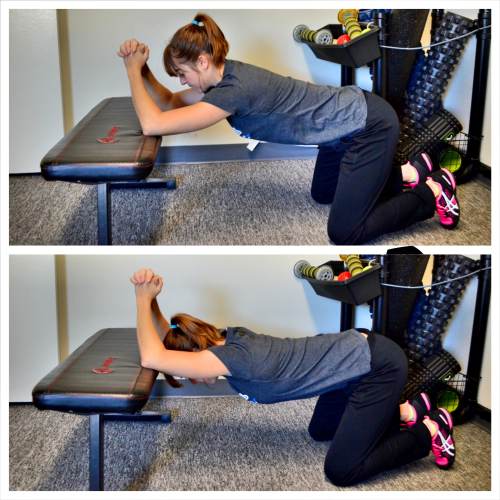
Quadruped Thoracic Rotation – To do the Quadruped Thoracic Rotation, start on your hands and knees with your knees under your hips and your hands under your shoulders. Then reach one hand down your neck and spine. With your hand behind your head, rotate your elbow down under your body toward your opposite knee, sitting your butt back slightly as you tuck. Then rotate the elbow up toward the ceiling as much as you can, opening your chest up toward the ceiling and pushing your hips slightly forward. Feel a nice stretch down your back and even into the outside of your hips. Repeat, rotating your elbow back under before twisting open. Complete all reps on one side before switching. Make sure to really rotate open as much as you can each time.
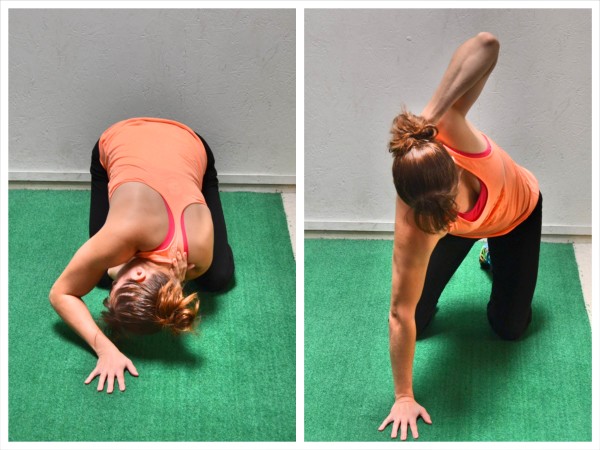
Lying Chest Stretch and Scorpion – To do the Lying Chest Stretch with Scorpion, lie on your belly with your arms out straight at shoulder height. Bend the elbow of one arm to 90 degrees so that your upper arm is still in line with your shoulder. Then lift the opposite leg up from the bent arm and bend your knee to kick your foot over and behind you as you press your chest open with your straight arm. Kick your leg back over your body, trying to touch your toe back behind you and feel a stretch through your chest and low back. You should feel a nice stretch down the front of the shoulder of the bent arm. Make sure as you reach the leg back over that you relax your head down onto the ground. Hold for a second or two then bend the other arm and kick the other leg back over. Alternate sides, holding for a second or two each way.

Camel – To do the Camel, start kneeling with your knees about hip-width apart and your feet flexed. Sit back on your heels and place your hands on your heels. Then arch your hips up and away, lifting your glutes up off your heels and pressing your chest out. Keep your hands on your heels as you arch away and squeeze your glutes to fully extend your hips. Relax your head back and arch as much as you can, getting a nice stretch down your chest, core, hips and quads. Do not let your shoulders shrug. Also make sure to squeeze your glutes so you don’t just feel this stretch straining your low back. Hold for 1-2 seconds and relax back down. Repeat, arching back up. You can also make this a static stretch by simply holding the pose for 15-20 seconds. If you want to make the stretch more challenging, point your toes and place your hands on your heels instead of flexing your feet (the two bottom photos).
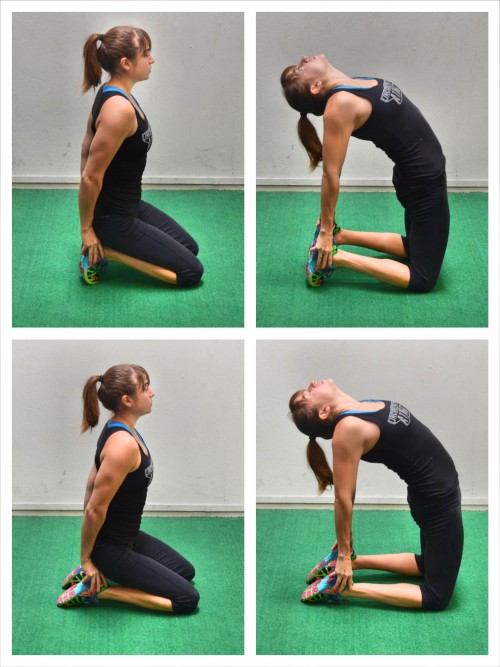
3-Way Scapular Band Flyes –
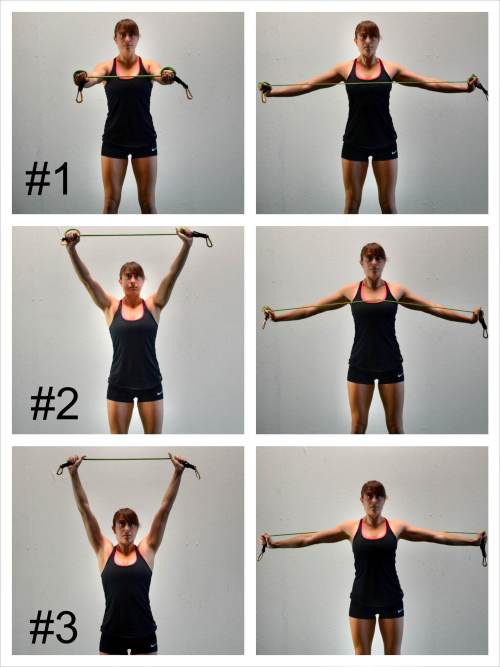
- #1 Straight Scapular Band Fly – To do the Straight Scapular Band Fly, hold the resistance band with your hands about shoulder-width apart. The closer together they are the harder the move will be and the farther apart they are the easier the move will be. Make sure that whatever distance you pick, you can open your arms straight out to the side and feel the correct muscles working. Press your chest out so you are standing nice and tall. Relax your neck and shoulders and engage your back muscles. Do not shrug. Raise your arms up straight in front of you at about shoulder height or right below, holding the band. Keeping your arms straight, pull your arms open and out to the sides, pulling the band open toward your chest. Pinch your shoulder blades down and together as you open and bring the band in to your chest. Do not let your shoulders shrug up as you pull the band. Focus on feeling your back work to pull your arms open. You want to pinch your shoulder blades together as you pull. Hold with your arms open for a second or two and feel your back working. After holding to feel your back working, bring your arms back together so your arms are about shoulder-width apart again and there is no slack in the band. Repeat the fly. Really focus on your back working and not your upper traps or neck. Do not round forward as you do this move or rush through it.
- #2 Overhead Scapular Band Fly – To do the Overhead Scapular Band Fly, you will hold the band with your hands about shoulder-width apart like you did for the Straight Scapular Band Fly. Then raise your arms out overhead and slightly in front of you. Keeping your arms straight, pull the band down to your chest by opening your arms straight out to the sides and down. Draw your shoulder blades down and together as you bring the band down. Your arms should stay straight the entire time as you bring the band down to your chest. Really press your chest out and make sure you to keep your shoulders and neck relaxed. Feel your shoulder blades retract down and back and the big muscles of your back working. Move slow and even pause at the bottom to assess and feel the correct muscles working.
- #3 Behind-The-Head Scapular Band Fly – The Behind-The-Head Scapular Band Fly is an overhead move in which you pull the band down behind your head. This is a more challenging variation so don’t attempt this one if you can’t feel the other two working the correct muscles. To do this variation, hold the band with your hands about shoulder-width apart and start with your arms up straight overhead. Then pull your arms straight out and down to bring the band down toward the back of your shoulders. Keep your chest pressed out and draw your shoulder blades down and back as you pull the band down. Try not to really jut your head forward as you pull it down behind your head. Pull it behind your head and bring your arms straight out to the side at about shoulder height. Once the band reaches your shoulders, slowly bring it back overhead. Really feel your back working. If you feel your neck or upper traps taking over, regress to the Band Fly you feel the most and then return to this one with a lighter resistance and focus on the correct muscles working.
Straight Arm Shoulder Extension – To do the Straight Arm Shoulder Extension, wrap the band around a leg of your desk and hold an end in each hand. Facing the anchor point, step away from the anchor point so there is tension in the band. Stand up nice and tall with your feet about hip-width apart and your arms straight down by your sides. Then, keeping your arms straight, pull back on the band. Stand up nice and tall as you pull back on the band. This won’t be a huge range of motion. Just focus on your back pulling the band back as your arms stay straight. Pinch your shoulder blades down and back as you pull back. Hold for a second or two then relax your arms back forward and repeat. Do not shrug your shoulders as you pull the band back. Also make sure your triceps don’t do all the work. Focus on your back working and maintaining a nice tall posture.
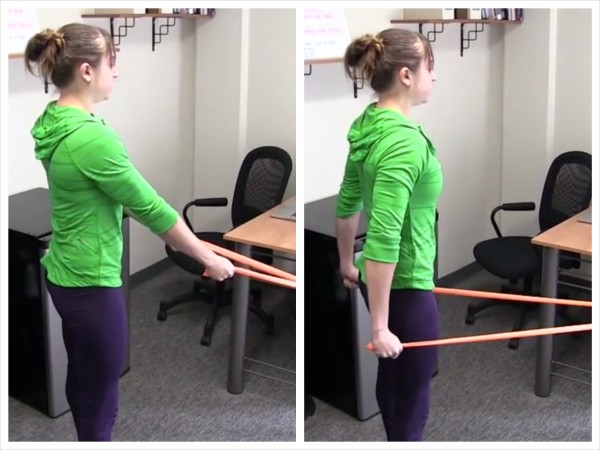
Scapular Wall Hold – To do the Scapular Wall Hold, stand with your back to the wall and your elbows bent in by your side. You can walk your feet out further from the wall to make the move harder, but really focus on feeling it between your shoulder blades no matter how far you walk out. Drive your elbows back into the wall and press your chest out and open toward the ceiling. Only your elbows should touch as you lean back and press your chest out. Draw your shoulder blades down and back and make sure to drive your chest out and open toward the ceiling. Think about driving your elbows back into the wall but also down toward your hips. Do not shrug your shoulders and keep your body in a nice straight line as if holding a plank. Keep your head in line with your spine and do not tuck your chin. Walk your feet back toward the wall to make the move easier or walk them away to make the move harder. Make sure to drive the chest out and draw your shoulder blades down and together as you hold. If you don’t feel the muscles low between your shoulders and even down the sides of your back working and instead feel your neck, walk your feet closer to the wall. You don’t need to be at a huge angle to feel this move working. If you do it correctly, you can even feel it working when standing basically straight against the wall.
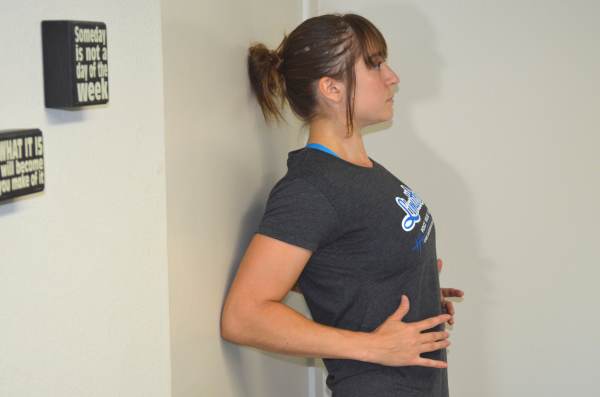
Mini Pull Ups – To do the Mini Pull Ups and work on engaging your lats to pull up, hang from the bar with your palms facing away from you (you can also do this with palms facing toward you for a Mini Chin Up). Your hands should be about shoulder-width apart although you can do it with them wider apart or closer together as well. I recommend using whatever grip you use when you do your Pull Ups. Hanging from the bar, press your chest out and pull your shoulder blades down and together. Feel your back engage as you draw your shoulder blades together. Don’t bend your elbows and turn this into a pull up. Just press your chest out and retract your shoulder blades bringing them down and together. Feel your back engage and pull you up toward the bar even though your arms aren’t moving. You should feel your shoulders go down as your chest lifts up. Then relax out and repeat. Remember, you are not bending your elbows to make this movement bigger.
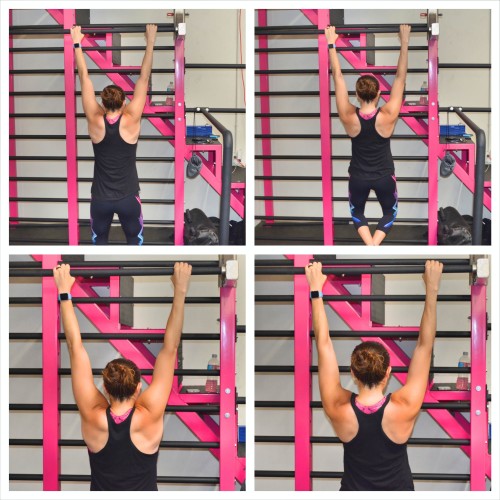
Halos – Stand with your feet not wider than hip-width apart . Grab the kettlebell by the handle with one hand on each side close to where the handle attaches to the bell. Turn the bell upside down and hold it upside down in front of your face. Squeeze your glutes and keep your core tight as you begin to circle the bell around your head. Point the bottom of the kettlebell backward as you circle it around the side of your head. As you drop it down behind your head, reach the bottom of the kettlebell down between your shoulder blades. Your elbows should point up toward the ceiling. Continue the circle and bring it around the other side and back in front of your face. Then go back the way you just came. Keep alternating directions until all reps are complete. Do not tuck your chin or move your head or core as you circle. Everything should be tight and still. Only the kettlebell is moving. Beginners will do fewer reps and go lighter. You can also use a dumbbell or plate weight.
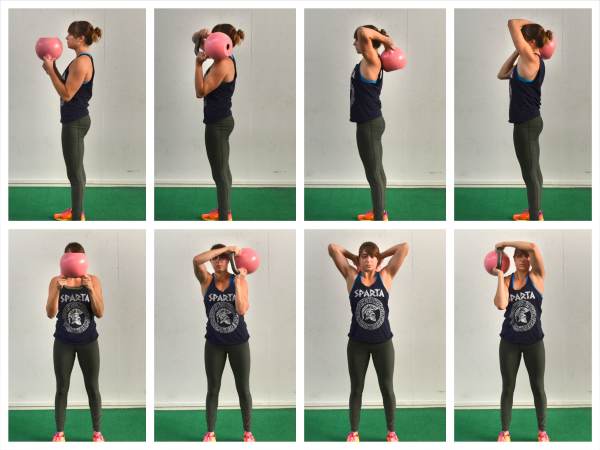
Dip Hold – To do the Dip Hold, sit on the edge of your chair with your hands down on the chair on each side of your body just outside of your butt. Your fingertips should hang over the edge of the chair. Slide your butt forward and off the chair, keeping your legs out straight in front of you. As you move your butt off the chair, press up to the top of the dip with arms straight down and shoulder blades drawn down and back. Press your chest out and do not tuck your chin or shrug your shoulders. Maintain a nice tall posture. Make sure you don’t press your hips up toward the ceiling as you hold the dip. You should remain in a seated position with your back and butt close to the chair. Hold at the top of the dip. If you start to shrug, relax out of the hold. Beginners may want to walk their feet back in toward the chair and bend their knees to take some strain off their upper body. Advanced exercisers will want to keep their legs out straight in front of them.
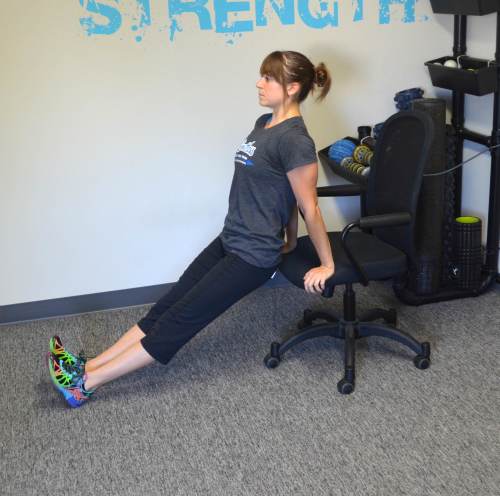
Inverted Rows – To do the Basic Inverted Row, you can either use a Suspension Trainer or a Bar. Using a Suspension Trainer, hold a handle in each hand with your palms facing in. Walk your feet forward so that your body is at an incline. The closer to parallel to the ground you get, the harder the move will be. Hang from the straps with your body in a nice straight line and your chest pressed out. Engage your core and glutes and keep your legs straight. You want a nice straight line from your head to your heels. Do not let your low back arch or your hips sag toward the ground. Then drive your elbows down and back to row your chest up to the handles. Keep your body in a nice straight line as you row up and do not bounce off the bottom. Keep your wrists straight as you row up. Also, do not shrug your shoulders. Then lower back down. Do not lose tension at the bottom. Make sure to keep the chest pressed out and your body in a nice straight line. Do not swing to row back up. Make sure to feel your back and arms working to row and not just your arms. Focus on feeling your back pull.
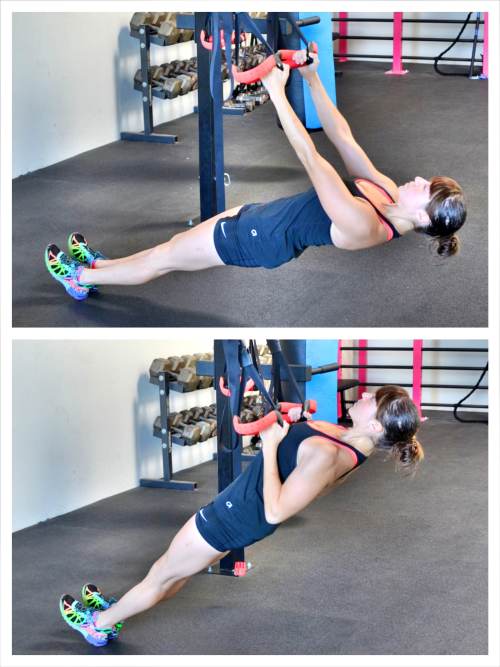
Plank with Shoulder Taps – To do Shoulder Taps, set up in a high plank position from your hands and toes (advanced) or hands and knees (beginner). You want your hands to be under your shoulders but closer together and your feet or knees should be wider apart to provide a more stable base. Bring your feet or knees together as the move becomes easier. Also, by having your hands closer together and more centered under your chest, you will provide yourself with a more stable base. It is very important that you remain stable with this move or you can stress your shoulder. Brace your abs and engage your glutes so that your body is in a nice straight line. Then from this plank position, lift one hand up off the ground, moving it slowly to touch the opposite shoulder. Keep your hips square to the ground and do not rotate. Also, do not let your butt go up in the air or your hips sag toward the ground. Touch your opposite shoulder than slowly place your hand back down on the ground. You want to move at a very controlled pace. Then lift the other hand and tap your other shoulder. Do not rotate as you lift. Try to keep your body still and simply lift the hand to touch the opposite shoulder.
